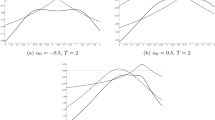Abstract
Model selection – choosing the relevant variables and structures –is a central task in econometrics. Given a limited number of observations,estimation and inference depend on this choice. A frequently treatedmodel-selection problem arises in multivariate autoregressive models, wherethe problem reduces to the choice of a dynamic structure. In most applicationsthis choice is based either on some ad hoc procedure or on a search within avery small subset of all possible models. In this paper the selection isperformed using an explicit optimization approach for a given informationcriterion. Since complete enumeration of all possible lag structures isinfeasible even for moderate dimensions, the global optimization heuristic ofthreshold accepting is implemented. A simulation study compares this approachwith the standard `take all up to the kth lag' approach. It is foundthat, if the lag structure of the true model is sparse, the thresholdaccepting optimization approach gives far better approximations.
Similar content being viewed by others
References
Akaike, H. (1969). Fitting autoregressive models for prediction. Annals of the Institute of Statistical Mathematics, 21, 243-247.
Althöfer, I and Koschnick, K.-U. (1991). On the convergence of 'Threshold Accepting'. Applied Mathematics and Optimization, 24, 183-195.
Dueck, G. and Scheuer, T. (1990). Threshold accepting: A general purpose algorithm appearing superior to simulated annealing. Journal of Computational Physics, 90, 161-175.
Goffe, W.L., Ferrier, G.D. and Rogers, J. (1994). Global optimization of statistical functions with simulated annealing. Journal of Econometrics, 60, 65-99.
Hamming, R.W. (1950). Error detecting and error correcting codes. Bell System Technical Journal, 29, 147-160.
Hannan, E.J. and Quinn, B.G. (1979). The determination of the order of an autoregression. Journal of the Royal Statistical Society (Series B), 41 (2), 190-195.
Holland, J.H. (1979). Adoption in Natural and Artificial Systems. University of Michigan Pres, Ann Arbor.
Jacobson, T. (1995). On the determination of lag order in vector autoregressions of cointegrated systems. Computational Statistics, 10, 177-192.
Johansen, S. (1991). Estimation and hypothesis testing of cointegration vectors in Gaussian vector autoregressive models. Econometrica, 59, 1551-1580.
Kirkpatrick, S., Gelatt, C. and Vecchi, M. (1983). Optimization by simulated annealing. Science, 220, 671-680.
Lütkepohl, H. (1985). Comparison of criteria for estimating the order of a vector autoregressive process. Journal of Time Series Analysis, 6 (1), 35-52.
Lütkepohl, H. (1991). Introduction to Multiple Time Series Analysis. Springer, Berlin.
McClave, J. (1975). Subset autoregression. Technometrics, 17, 213-220.
Pötscher, B.M. (1991). Effects of model selection on inference. Econometric Theory, 7, 163-185.
Quinn, B.G. (1980). Order determination for a multivariate autoregression. Journal of the Royal Statistical Society (Series B), 42 (2), 182-185.
Shibata, R. (1976). Selection of the order of an autoregressive model by Akaike's information criterion? Biometrika, 63, 117-126.
Winker, P. (1995). Identification of multivariate AR-models by threshold accepting. Computational Statistics and Data Analysis, 20, 295-307.
Winker, P. and Fang, K.-T. (1997). Application of threshold accepting to the evaluation of the discrepancy of a set of points. SIAM Journal on Numerical Analysis, 34, 2028-2042.
Zellner, A. (1962). An efficient method of estimating seemingly unrelated regressions, and tests for aggregation bias. Journal of the American Statistical Association, 57, 348-368.
Author information
Authors and Affiliations
Rights and permissions
About this article
Cite this article
Winker, P. Optimized Multivariate Lag Structure Selection. Computational Economics 16, 87–103 (2000). https://doi.org/10.1023/A:1008757620685
Issue Date:
DOI: https://doi.org/10.1023/A:1008757620685




